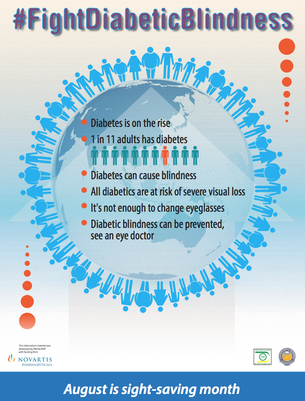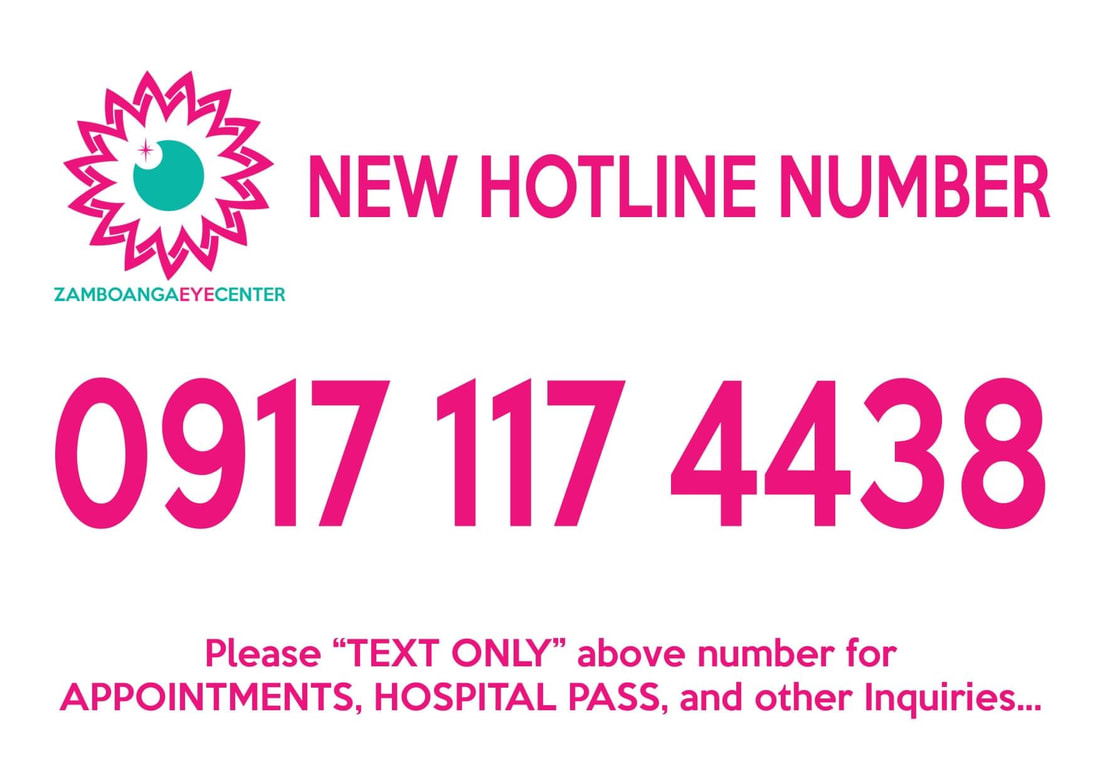DIABETES and the EYE
(This information material was developed by Philippine Academy of Ophthalmology (PAO), Philippine Society of Endocrinology, Diabetes and Metabolism (PSEDM) & Vitreoretina Society of the Philippines (VRSP) with funding from Novartis Healthcare Philippines, Inc.)
The problem with diabetes mellitus is that the body cannot use sugar (glucose, carbohydrates) correctly. This results in high blood sugar levels which lead to many other problems. The eye is one of the organs affected by diabetes mellitus. Eye problems which may occur include: cataracts, glaucoma, optic nerve problems and most significantly, diabetic retinopathy. What is Diabetic Retinopathy? Diabetic Retinopathy is “diabetes of the retina”. It is a blinding disease. The retina is the inner lining of the eye. Diabetes causes changes in the retinal blood vessels, which results in blood and fluid in the eye. This causes blurring of vision that cannot be fixed by eyeglass prescriptions. What happens in Diabetic Retinopathy? The problem with diabetes mellitus is that the body cannot use sugar (glucose, carbohydrates) correctly. This results in high blood sugar levels which lead to many other problems. The eye is one of the organs affected by diabetes mellitus. Eye problems which may occur include: cataracts, glaucoma, optic nerve problems and most significantly, diabetic retinopathy. What are the symptoms of Diabetic Retinopathy? Most patients with beginning Diabetic Retinopathy have no symptoms in the early stages. The most common symptom is gradual, continuous blurring of vision. The blurring may be mild to severe depending on how serious the retinopathy is. In the advanced stages, vision may slowly deteriorate or vision loss may be sudden and severe due to the bleeding of the vessels into the fluid or vitreous of the eye. Blurring of vision, may however, also be due to a gradually thickening cataract. How is Diabetic Retinopathy detected? To find out if a patient has Diabetic Retinopathy, an eye exam is performed. This includes checking for cataracts and glaucoma and doing retina screening by a retina specialist. The pupil will need to be dilated to see the retina better. Other tests may also be requested such as Color Photos, Fluorescein Angiography (FA) or Optical Coherence Tomography (OCT) Fluorescein Angiography (FA) is a test which allows analysis of the blood vessels of the retina. FA is not done in all patients. It is requested when the seriousness of the retinopathy cannot be determined by color photos. Optical Coherence Tomography (OCT) may also be recommended. This exam checks for the presence of macular edema, which is the most common cause of blurring of vision among diabetic patients. Who should have eye checks? All individuals with diabetes should go for retina checks even if they do not have any blurring of vision. Children with diabetes should have their retina checked as soon as they reach puberty. Adults should have their retina checked as soon as they are diagnosed to have diabetes. Diabetics who become pregnant should have the retina checked every trimester or as recommended by the retina specialist. If a patient develops diabetes while pregnant, check up every 3 months is recommended. Treatment depends on how severe the retinopathy is. If the retinopathy is still in the early or moderate stages, repeated eye checks are recommended. If cataracts are present, a cataract operation may be recommended. If the Diabetic Retinopathy is found to be progressing to the advanced stage, treatment may be done to improve vision and/or to control the retinopathy. At the appropriate stage, injections of medicine into the eye and/or laser for the retina may be recommended. Laser treatment or Pan Retinal Photocoagulation (PRP) is performed to prevent bleeding by stopping the growth of abnormal blood vessels. Focal laser treatment and/or injections of medications are done to treat macular edema. It is also important to note that the correct timing of injections and/or PRP can prevent blindness. If cataracts are present, a cataract operation may be recommended. If bleeding is noted in the vitreous, a surgical procedure called pars plana vitrectomy may be recommended to remove the blood and apply laser treatment What can be done to prevent vision loss from Diabetic Retinopathy? Prevention is possible by very strict control of blood sugar and by early detection of diabetic retinopathy. This can be done by regular checks with both the diabetes doctor and the eye specialist. It is important that the patient goes back to the retina-eye doctor for follow-up at the time recommended even if the patient does not have blurring of vision. This is because diabetic retinopathy starts quietly and the patients may experience eye problems only when the disease is in its more advanced stages. Early detection is key. #FightDiabeticBlindness Zambo Eyecare Center ready to serve Western Mindanao
Ciudad Medical Zamboanga (CMZ) officially launched yesterday morning (August 15, 2012) its Eye Care Center to better serve the Zamboangueños and others in Zamboanga Peninsula. Read more
Ciudad Medical doctors to perform first eye vitrectomy in Zamboanga
Ciudad Medical Zamboanga (CMZ), Zamboanga Eye Care Center is set to perform the first vitrectomy of the eye in the city with membrane peeling and endolaser on two patients on August 16 at CMZ. Read more |
Visit usCIUDAD MEDICAL ZAMBOANGA
Room 116, Ciudad Medical Zamboanga Mayor Vitaliano Agan Avenue Camino Nuevo, Zamboanga City Philippines 7000 Cellphone: +63 917 117 4438 Tel: +63 (62) Clinic HoursMonday to Saturday
9:00am -12:00pm NO APPOINTMENT NO MASK NO ENTRY Accredited by:and ALL other HMOs are accepted.
|


